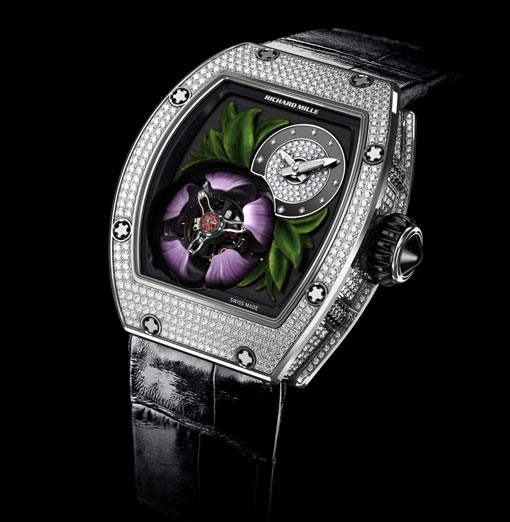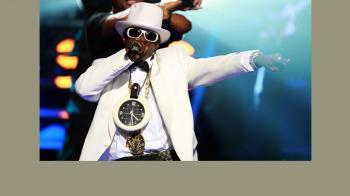Size is about far more than just numbers. It is a matter of trends, techniques, style and relevance. Witness Flavor Flav, a member of the Public Enemy hip hop group, who has spent his entire career wearing a giant clock around his neck. Regarded by some as a clown and by others as a masterful provocateur, he successfully made his mark on the pop culture of the 1990s largely thanks to this unusual accessory.
Up until the 1960s, a large men’s watch generally measured no more than 36 mm across. Any models larger than that were exceptions governed by functional considerations. Military and diver’s watches were rarely seen in civilian circles. The psychedelic years momentarily released diameters from these constraints and certain models swelled to 40 mm or more, before shrinking again like collapsed soufflés. It was not until 1993 and the iconic 42 mm Royal Oak Offshore by Audemars Piguet that the fashion for oversized models with ostentatious widths truly began to take off. It experienced a historical peak around 2008, a period when 48 mm watches (sometimes 16 mm thick) were no longer fanciful exceptions but met a real market demand.
The norm and the craze have since settled down to more modest proportions, with average diameters currently hovering around 40 to 41 mm. Yet the current trend is not confined to this mean, and the diversity of watchmaking styles is matched by the diversity of the markets. Between the large sizes favoured in northern China, the United States and Russia, the penchant for ostentation typical of South-East Asia and Latin America, the conservative tastes of continental Europe and diminutive Japanese wrists, all manner of morphological and sociological stereotypes exercise their corresponding influences. The one sure thing is that models are required to match all tastes and all size preferences.

The spectrum now ranges from 34 mm to 50 mm for men, and is even wider for ladies’ models, since women have never stopped either “borrowing” or imitating their partner’s watches, while no longer shying away from downsizing to models so small that one practically needs a magnifying glass to read the time. At around 20 mm in diameter, you definitely need pretty good eyesight. Conversely, wearing a 50 mm pilot’s watch is easier to carry off if you’re well over 6 foot-tall and powerfully built!

Diameter is a very relative quantity. Wearer comfort calls for an appropriate correlation between the size of the case and that of the wrist. Otherwise the watch ends up shifting, turning, slipping, knocking against objects or tearing shirt cuffs. The only remedy is ergonomics. A curved case-back and dipping lugs can ensure a smooth fit for even a 48 mm case on a slender wrist, including that of a man. Yet few brands have opted for this approach, especially since it increases the complexity of production and design, as Richard Mille has clearly grasped.

The size of cases bears a clear correlation to what they contain. And a movement is far more expensive and more time-consuming to develop than a case. The initial years of oversize watches thus saw models equipped with calibres that were far too small for the watches accommodating them. The results included small seconds far too close to the centre, “cross-eyed” chronograph counters, power-reserve indicators lost amid the vast expanse of excessively large dials… The watches of the 2000s were attired in jackets that were too large and trousers that were too long. Yet in watchmaking, form and substance are inseparable, because any short-cuts and easy ways out are immediately apparent.

Another factor that contributed to raising the diameter stakes was the growing profusion of complications and the need to read them easily, leading to larger apertures and indications, in due course followed by the movements themselves. Long-sighted wearers were delighted… until sizes shrank once more.
The size wars run even deeper than there. There is a technological debate between those who think that one should make larger or smaller models. By way of example, Blancpain uses small, light balance wheels that resume their oscillations instantly after a momentary disturbance. Others take the opposite approach and want large, heavy, high-inertia balance-wheels, properties that protect them from shocks and preserve their amplitude. Chronometry tests do not show a clear winner in this particular battle.
When it comes to minute repeater watches, is it better to have a small movement that fits snugly inside the case so that the sound emitted by the calibre is more effectively transmitted to its housing? Or is it preferable to go for a large case so as to create a sounding board? The jury is still out on that one, even after 15 years of constant progress in this field.
In the field of power reserves, Chopard achieves a substantial degree of autonomy by using two sets of two small stacked barrels: its Quattro system delivering a nine-day power reserve. At the opposite end of the spectrum, Oris adops a single but far larger barrel, capable of running for ten days without rewinding. So size does indeed matter, but what counts even more is how it is used…











